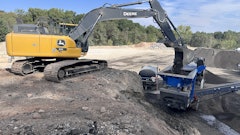
What business activity makes the most money for your construction company? I bet you didn’t say sales! To most contractors, their total sales effort is no more than waiting for a request to bid to show up, then downloading the plans from a customer, estimating the job, turning in a bid, and then waiting for the results. They rely heavily on price to sell most jobs.
As the competition has increased and the profit margins continue to stay low, many company owners have thought about how to increase their profitable sales to make more money. Some have even decided to hire a salesperson to increase their revenue. But then what? These frustrated owners don’t know how to manage a salesperson or an effective business development program to get the results they need or want.
It’s a numbers game. When professional salespeople make regular sales calls on the right targeted prospects, your company will get your share of their business. When you don’t make sales calls, you won’t get the business. It’s like professional hockey. The team that takes the most shots, usually wins the game.
The more sales calls, the more new business. Simple and easy. Most construction business owners don’t like to make sales calls. So they try to encourage their estimator to make them. Most estimators are not built to sell. They’re built to analyze at a set of plans, use their calculators and computers, and put a price on a specified amount of work. Like business owners, estimators also don’t like to get out of their comfort zone, go out and make sales calls, and spend any time selling.
Why do companies stop profitable growth?
A major reason small to medium size construction companies struggle is caused by not implementing an effective sales and marketing plan. They mainly rely on winning business by waiting and hoping old customers call. They also hope their reputation will earn them enough work to make some profit. Highly profitable contractors have written sales systems and pro-active marketing plans to systematically and aggressively seek, track and attack loyal, repeat and new customers.
As a general contractor, I observed the common sales system successful subcontractors implemented. They use a diligent effective program to win lots of profitable work, keep customers loyal, and attract new high margin customers. Every week they come by their customer’s offices as a part of their regular sales routine to meet with general contractor estimators, project managers and owners to build relationships with those who influence and award contracts.
They always seem to be in the right place at the right time and are always in the selling mode ready when an opportunity arises. Less successful contractors are reactive and wait until customers call.
Read next: 8 Tested Techniques for Getting Sales Now
A pro-active sales plan starts with a required standard of performance excellence. These winning standards include the number of sales calls per day, number of customer lunches per week, number of face to face meetings per week, number of proposals, and total proposal volume per month. To know how you’re doing, you’ve got to keep score.
Keeping score with salespeople is often difficult, as they tend to not want to be tied down to a set number of calls required. They like to let their instincts take them through the day. They don’t like to be held accountable to a minimum standard, and don’t like to track numbers. They also don’t like to write, don’t like discipline, and don’t want to follow a written plan. They generally feel their gift of gab will get them through and reap enough results.
But without numbers to hit, most salespeople will fail and not meet your expectations.
Sales numbers to track:
- Type of customers you want
- Markets you want to attack
- Project locations you like
- Project sizes you want
- Minimum fee per job
- Sales calls per day
- Leads from calls
- Face to face meetings per week
- Proposals from leads
- Proposal follow-up tracking
- Proposals or bids hit
- Referrals from customers
- Average job size
- Average profit margin
What’s your sales success system?
To win more jobs, you must know your numbers and keep track of your weekly sales efforts. Every Monday sit down with your sales, estimating, and project managers to review the sales progress from the previous week, and layout a sales plan for the next four upcoming weeks. Without a weekly sales meeting, everyone stays busy doing their jobs, working with existing customers, bidding, building projects, and don’t put a top focus or priority on winning new contracts or building relationships with existing customers.
Read next: 10 Steps to Winning More Construction Customer Sales
Laying out a sales plan starts with determining how much business you need to cover your overhead plus meet your profit goals. Follow this example to review how sales numbers tracking works:
Acme Construction Company
1. Annual Overhead $ 750,000
2. Annual Profit Goal $ 250,000
3. Total Overhead + Profit Goal $ 1,000,000
4. Average Gross Profit Margin anticipated 20%
5. Annual Sales required to meet goals $ 5,000,000
7. Average Job Size $ 250,000
8. Jobs Needed 20
9. Average Bid-Hit Ratio @ 1 / 5 20%
10. Annual Bids needed 100
11. Bids & Proposals needed per month 8.3
12. Face To Face Meetings Per Bid @ 1 / 3 33%
13. Face To Face Meetings needed per month 25
14. Sales phone calls per Appointment made 25%
16. Sales Phone Calls needed per month 100
In this example, Acme Construction needs to do $5,000,000 in sales to generate $1,000.000 in Gross Margin (overhead and profit) for the upcoming year. Based on the market they’re in and track record, they’re averaging awards on one winning project for every five they bid. With an average job size of $250,000, they need to be awarded 20 jobs this year. This equals 100 bids or proposals will be required for them to hit their goals.

Track you progress to win more work
The question is, how many calls can a salesperson make or how many sales people does it take to keep this sales plan working? In most companies, a portion of new work opportunities come from existing customers and referral lead sources. And another portion must come from your sales effort. How many sales phone calls, face to face meetings, and appointments can a salesperson make in a week? The best way to find out is to ask your salesperson and then keep track. You’ll find that at a minimum, a good salesperson should average a minimum of two to four phone cold calls per hour and at least two to three face to face meaningful meetings a day. That doesn’t sound like much, but it will be enough if they are calling on the right customer targets.
Read next: How to Achieve Your Business Targets and Goals
Based on the Acme example, 25 meetings are needed every month. If a sales person makes 2 face to face meetings a day, they should be able to meet the companies goals. Based on Acme’s needs, they would set the salesperson’s performance goals as follows:
Sales Performance Goals
- Phone Sales Calls per week: 25 to 35
- Customer Meetings per week: 7 to 15
- Bids & Proposals needed per month: 8 to 10
Sales Tracking Report
In order to keep your sales people focused on the right projects and new customer targets, you will have to manage the process. Every Monday, review every lead, sales phone call, and customer meeting with your salesperson. Review which customers targets were attempted and which are still needed. Create a new list of leads to attack and keep the salesperson focused on the big targets. This meeting will insure your sales efforts continue. Over time, some salespeople tend to stop going after new accounts as they get comfortable on their route of customers they know. The tracking system will keep them on track with existing and new customers to call on.
Sales Tracking Log
- Date
- Customer Target
- Contact & Information
- Opportunity
- Follow-Up
- Type
The ‘Type’ refers to the type of contact your salesperson had with the customer. It could be a Phone Call, Meeting, Meal, Event, Bid, or Proposal. I am a firm believer that a phone call or email are tools to set meetings with your customers. In hockey, you don’t win the games making good passes, only by taking good shots at the goal.
In sales tracking, I don’t give salespeople credit for phone calls. Only face to face meetings or appointments count. On the phone, customers don’t always tell you everything you need to know about the potential project. In a face to face setting, you can start to build relationships, read your customer’s body language, and get to really know them. So the more meetings, the more success will happen. And frequency is the key to unlocking success in your sales team. As J. Paul Getty once said: ‘Rise early, work late & strike oil!” To be successful in sales: “Rise early, work late & strike often!”
 Author George Hedley
Author George Hedley



















